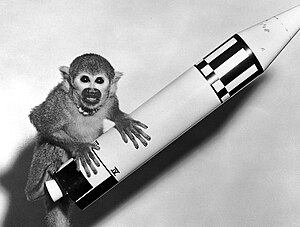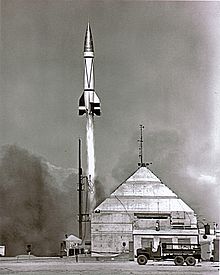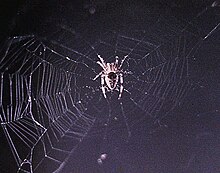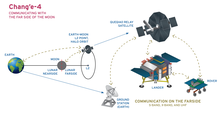Space pioneer Miss Baker, a squirrel monkey, rode a Jupiter IRBM into space in 1959.
| Landmarks for animals in space |
| 1947: First animal in space |
| 1949: First monkey in space |
| 1951: First dogs in space |
| 1957: First animal in orbit |
| 1968: First animals in deep space and to circle the Moon |
| 2007: First animal survives exposure to space |
Non-human animals in space originally served to test the survivability of spaceflight, before human spaceflights were attempted. Later, other non-human animals were flown to investigate various biological processes and the effects microgravity and space flight might have on them. Bioastronautics is an area of bioengineering research which spans the study and support of life in space. To date, seven national space programs have flown animals into space: the Soviet Union, the United States, France, Argentina, China, Japan and Iran.
A wide variety of non-human animals have been launched into space, including monkeys, dogs, tortoises, mice, and insects. The United States launched flights containing monkeys and primates primarily between 1948-1961 with one flight in 1969 and one in 1985. France launched two monkey-carrying flights in 1967. The Soviet Union and Russia launched monkeys between 1983 and 1996. During the 1950s and 1960s, the Soviet space program used a number of dogs for sub-orbital and orbital space flights. Two tortoises and a variety of insects were the first inhabitants of Earth to circle the Moon, on the 1968 Zond 5 mission, and five mice traveled in the orbiter of the 1972 Apollo 17 mission.
Background
Animals had been used in aeronautic exploration since 1783 when the Montgolfier brothers
sent a sheep, a duck, and a rooster aloft in a hot air balloon to see
if ground-dwelling animals can survive (the duck serving as the experimental control). The limited supply of captured German V-2
rockets led to the U.S. use of high-altitude balloon launches carrying
fruit flies, mice, hamsters, guinea pigs, cats, dogs, frogs, goldfish
and monkeys to heights of up to 44,000 m (144,000 ft; 27 mi).
These high-altitude balloon flights from 1947 to 1960 tested radiation
exposure, physiological response, life support and recovery systems. The
U.S. high-altitude manned balloon flights occurred in the same time
frame, one of which also carried fruit flies.
V2 launch No. 47 carried the monkey Albert II into space.
1940s
The first animals sent into space were fruit flies aboard a U.S.-launched V-2 rocket on 20 February 1947 from White Sands Missile Range, New Mexico.
The purpose of the experiment was to explore the effects of radiation
exposure at high altitudes. The rocket reached 68 miles (109 km) in 3
minutes and 10 seconds, past both the U.S. Air Force 50-mile and the international 100 km
definitions of the boundary of space. The Blossom capsule was ejected
and successfully deployed its parachute. The fruit flies were recovered
alive. Other V-2 missions carried biological samples, including moss.
Albert II, a rhesus monkey, became the first monkey in space
on 14 June 1949, in a U.S.-launched V-2, after the failure of the
original Albert's mission on ascent. Albert I reached only 30–39 miles
(48–63 km) altitude; Albert II reached about 83 miles (134 km). Albert
II died on impact after a parachute failure. Numerous monkeys of several
species were flown by the U.S. in the 1950s and 1960s. Monkeys were
implanted with sensors to measure vital signs, and many were under
anesthesia during launch. The death rate among monkeys at this stage was
very high: about two-thirds of all monkeys launched in the 1940s and
1950s died on missions or soon after landing.
1950s
On 31 August 1950, the U.S. launched a mouse
into space (137 km) aboard a V-2 (the Albert V flight, which, unlike
the Albert I-IV flights, did not have a monkey), but the rocket
disintegrated because the parachute system failed.[6] The U.S. launched several other mice in the 1950s.
On 22 July 1951, the Soviet Union launched the R-1 IIIA-1 flight, carrying the dogs Tsygan (Russian: Цыган, "Gypsy") and Dezik (Russian: Дезик) into space, but not into orbit. These two dogs were the first living higher organisms successfully recovered from a spaceflight. Both space dogs
survived the flight, although one would die on a subsequent flight. The
U.S. launched mice aboard spacecraft later that year; however, they
failed to reach the altitude for true spaceflight.
On 3 November 1957, the second-ever orbiting spacecraft carried the first animal into orbit, the dog Laika, launched aboard the Soviet Sputnik 2
spacecraft (nicknamed 'Muttnik' in the West). Laika died during the
flight, as was intended because the technology to return from orbit had
not yet been developed. At least 10 other dogs were launched into orbit and numerous others on sub-orbital flights before the historic date of 12 April 1961, when Yuri Gagarin became the first human in space.
On 13 December 1958, a Jupiter IRBM, AM-13, was launched from Cape Canaveral, Florida, with a United States Navy-trained South American squirrel monkey named Gordo on board. The nose cone recovery parachute failed to operate and Gordo was lost. Telemetry data sent back during the flight showed that the monkey survived the 10 g
of launch, 8 minutes of weightlessness and 40 g of reentry at 10,000
miles per hour (16,000 km/h). The nose cone sank 1,302 nautical miles
(2,411 km) downrange from Cape Canaveral and was not recovered.
Monkeys Able and Baker became the first monkeys to survive spaceflight after their 1959 flight. On 28 May 1959, aboard Jupiter IRBM AM-18, were a 7-pound (3.18 kg) American-born rhesus monkey, Able, from Independence, Kansas, and an 11-ounce (310-gram) squirrel monkey
from Peru, Baker. The monkeys rode in the nose cone of the missile to
an altitude of 360 miles (579 km) and a distance of 1,700 miles
(2,735 km) down the Atlantic Missile Range from Cape Canaveral, Florida.
They withstood forces 38 times the normal pull of gravity and were
weightless for about 9 minutes. A top speed of 10,000 mph (16,000 km/h)
was reached during their 16-minute flight. The monkeys survived the
flight in good condition. Able died four days after the flight from a
reaction to anesthesia, while undergoing surgery to remove an infected
medical electrode. Baker was the center of media attention for the next
several months as she was watched closely for any ill-effects from her
space flight. She was even mated in an attempt to test her reproductive
system. Baker lived until 29 November 1984, at the US Space and Rocket Center in Huntsville, Alabama.
On 2 July 1959, a launch of a Soviet R2 rocket, which reached 212
kilometers (132 mi), carried two space dogs and Marfusa, the first
rabbit to go into space.
A 19 September 1959 launch, Jupiter AM-23, carried 2 frogs along with 12 mice but the rocket was destroyed during launch.
1960s
On 19 August 1960 the Soviet Union launched Sputnik 5 (also known as Korabl-Sputnik 2) which carried the dogs Belka and Strelka, along with a gray rabbit, 40 mice, 2 rats, and 15 flasks of fruit flies and plants. It was the first spacecraft to carry animals into orbit and return them alive. One of Strelka's pups, Pushinka, bred and born after her mission, was given as a present to Caroline Kennedy by Nikita Khrushchev in 1961, and many descendants are known to exist.
The United States sent three black mice: Sally, Amy and Moe
1,000 km up and 8,000 km distance from Cape Canaveral on 13 October 1960
using an Atlas D 71D launch vehicle. The mice were retrieved from the
nosecone near Ascension Island and were said to be in good condition.
On 31 January 1961, Ham the Chimp was launched in a Mercury capsule aboard a Redstone rocket. Ham's mission was Mercury-Redstone 2. The chimpanzee had been trained to pull levers to receive rewards of banana pellets and avoid electric shocks. His flight demonstrated the ability to perform tasks during spaceflight. A little over 3 months later the United States sent Alan Shepard into space. Enos the chimp became the first chimpanzee in orbit on 29 November 1961, in another Mercury capsule, an Atlas rocket, Mercury-Atlas 5.
On 9 March 1961 the Soviet Union launched the Korabl-Sputnik 4 that carried a dog named Chernushka, some mice, frogs and, for the first time into space, a guinea pig. All were successfully recovered.
France flew their first rat (Hector) into space on 22 February 1961. Two more rats were flown in October 1962.
On 18 October 1963, France launched Félicette
the cat aboard Veronique AGI sounding rocket No. 47. The launch was
directed by the French Centre d'Enseignement et de Recherches de
Médecine Aéronautique (CERMA). Félicette was recovered alive after a
15-minute flight and a descent by parachute. Félicette had electrodes
implanted into her brain, and the recorded neural impulses were
transmitted back to Earth. A second cat was sent to space by CERMA on 24
October 1963, but the flight ran into difficulties that prevented
recovery. The final French animal launches were of two monkeys in March 1967.
China launched mice and rats in 1964 and 1965, and two dogs in 1966.
During the Voskhod program,
two Soviet space dogs, Veterok (Ветерок, Little Wind) and Ugolyok
(Уголёк, Blackie), were launched on 22 February 1966, on board Cosmos 110
and spent 22 days in orbit before landing on 16 March. This spaceflight
of record-breaking duration was not surpassed by humans until Soyuz 11 in 1971 and still stands as the longest space flight by dogs.
The United States launched Biosatellite I in 1966 and Biosatellite I/II in 1967 with fruit flies, parasitic wasps, flour beetles and frog eggs, along with bacteria, amoebae, plants and fungi.
On 11 April 1967, Argentina also launched the rat Belisario, atop a Yarará rocket,
from Cordoba military range, which was recovered successfully. This
flight was followed by a series of subsequent flights using rats. It is unclear if any Argentinean biological flights passed the 100 km limit of space.
The first animals in deep space, the first to circle the Moon, and the first two tortoises in space were launched on Zond 5 on 14 September 1968 by the Soviet Union. The Horsfield's tortoises were sent on a circumlunar voyage to the Moon along with wine flies, meal worms,
and other biological specimens. These were the first inhabitants of
Earth to travel around the Moon. The capsule overshot its terrestrial
landing site but was successfully recovered at sea on 21 September. The
animals survived but suffered some weight loss.
On 28 June 1969, the United States launched the monkey Bonny, a macaque, on Biosatellite 3
in what was intended to have been a 30-day orbit around the Earth, with
the monkey being fed by food pellets from a dispenser that he had been
trained to operate. However, Bonny's health deteriorated rapidly and he
was returned to Earth on July 7, but died the next day after the Biosatellite capsule was recovered in the Pacific Ocean.
In total in the 1950s and 1960s, the Soviet Union launched
missions with passenger slots for at least 57 dogs. The actual number of
dogs in space is smaller, because some dogs flew more than once.
On 23 December 1969, as part of the 'Operación Navidad' (Operation Christmas), Argentina launched Juan (a cai monkey, native of Argentina's Misiones Province) using a Canopus II rocket. It ascended 82 kilometers[22]
and then was recovered successfully. Later, on 1 February 1970 the
experience was repeated with a female monkey of the same species using a
X-1 Panther rocket. It reached a higher altitude than its predecessor,
but it was lost after the capsule's parachute failed.
1970s
Two bullfrogs were launched on a one-way mission on the Orbiting Frog Otolith satellite on 9 November 1970, to understand more about space motion sickness.
Apollo 16 on 16 April , 1972, carried nematodes, and Apollo 17, launched on 7 December 1972, carried five pocket mice, Fe, Fi, Fo, Fum, and Phooey, although one died on the circumlunar trip.
Skylab 3 carried pocket mice and the first fish in space (a mummichog), and the first spiders in space (garden spiders named Arabella and Anita). Mummichog were also flown by the U.S. on the Apollo-Soyuz joint mission, launched 15 July 1975.
The Soviets flew several Bion program missions which consisted of satellites with biological cargoes. On these launches they flew tortoises, rats, and mummichog. On Soyuz 20, launched 17 November 1975, tortoises set the duration record for an animal in space when they spent 90.5 days in space. Salyut 5 on 22 June 1976, carried tortoises and a fish (a zebra danio).
1980s
The Soviet Union sent eight monkeys into space in the 1980s on Bion flights. In 1985, the U.S. sent two squirrel monkeys aboard Spacelab 3 on the Space Shuttle with 24 male albino rats and stick insect eggs. Bion flights also flew zebra danio, fruit flies, rats, stick insect eggs and the first newts in space.
Bion 7 (1985) had 10 newts (Pleurodeles waltl) on board. The newts had part of their front limbs amputated, to study the rate of regeneration in space, knowledge to understand human recovery from space injuries.
After an experiment was lost in the Space Shuttle Challenger disaster, chicken embryos (fertilized eggs) were sent into space in an experiment on STS-29 in 1989. The experiment was designed for a student contest.
1990s
Four monkeys flew aboard the last Bion flights of the Soviet Union as well as frogs and fruit flies. The Foton program flights carried dormant brine shrimp (Artemia franciscana), newts, fruit flies, and sand desert beetles (Trigonoscelis gigas).
Astronaut Donald Thomas examines a newt on the Space Shuttle Columbia during a 1994 mission
China launched guinea pigs in 1990.
Toyohiro Akiyama, a Japanese journalist carried Japanese tree frogs with him during his trip to the Mir space station in December 1990. Other biological experiments aboard Mir involved quail eggs.
Japan launched its first animals, a species of newt, into space on 18 March 1995 aboard the Space Flyer Unit.
During the 1990s the U.S. carried crickets, mice, rats, frogs, newts, fruit flies, snails, carp, medaka, oyster toadfish, sea urchins, swordtail fish, gypsy moth eggs, stick insect eggs, brine shrimp (Artemia salina), quail eggs, and jellyfish aboard Space Shuttles.
2000s
The last flight of Columbia in 2003 carried silkworms, garden orb spiders, carpenter bees, harvester ants, and Japanese killifish (medaka). Nematodes (C. elegans) from one experiment were found still alive in the debris after the Space Shuttle Columbia disaster.
C. elegans are also part of experiments aboard the International Space Station as well as research using quail eggs.
Earlier Space Shuttle missions included grade school, junior high and high school projects; some of these included ants, stick insect eggs and brine shrimp cysts. Other science missions included gypsy moth eggs.
On 12 July 2006, Bigelow Aerospace launched their Genesis I
inflatable space module, containing many small items such as toys and
simple experiments chosen by company employees that would be observed
via camera. These items included insects, perhaps making it the first
private flight to launch animals into space. Included were Madagascar hissing cockroaches and Mexican jumping beans — seeds containing live larvae of the moth Cydia deshaisiana. On 28 June 2007, Bigelow launched Genesis II, a near-twin to Genesis I. This spacecraft also carried Madagascar hissing cockroaches and added South African flat rock scorpions (Hadogenes troglodytes) and seed-harvester ants (Pogonomyrmex californicus).
In September 2007, during the European Space Agency's FOTON-M3 mission, tardigrades, also known as water-bears, were able to survive 10 days of exposure to open-space with only their natural protection.
On the same mission, a number of cockroaches were carried inside a
sealed container and at least one of the females conceived during the
mission. After they were returned to earth, the one named Nadezhda became the first Earth creature to produce young that had been conceived in space.
On 15 March 2009, during the countdown of the STS-119, a free-tailed bat
was seen clinging to the fuel tank. NASA observers believed the bat
would fly off once the shuttle started to launch, but it did not. Upon
analyzing the images, a wildlife expert who provided support to the
center said it likely had a broken left wing and some problem with its
right shoulder or wrist. The animal most likely perished quickly during Discovery's climb into orbit.
In November 2009, STS-129 took painted lady and monarch butterfly larvae into space for a school experiment as well as thousands of C. elegans roundworms for long-term weight loss studies.
2010s
On 3 February 2010, on the 31st anniversary of its revolution, Iran became the latest country to launch animals into space. The animals (a mouse, two turtles and some worms) were launched on top of the Kavoshgar 3 rocket and returned alive to Earth.
In May 2011, the last flight of Space Shuttle Endeavour (STS-134) carried two golden orb spiders,
named Gladys and Esmeralda, as well as a fruit fly colony as their food
source in order to study the effects of microgravity on spiders'
behavior. Tardigrades and extremophiles were also sent into orbit.
In November 2011, the Living Interplanetary Flight Experiment on the Fobos-Grunt mission planned to carry tardigrades to Mars and back; however, the mission failed to leave Earth orbit.
In October 2012, 32 medaka fish were delivered to the International Space Station by Soyuz TMA-06M for the new Aquatic Habitat in the Kibo module.
On 28 January 2013, Iranian news agencies reported that Iran sent a monkey in a "Pishgam"
rocket to a height of 72 miles (116 km) and retrieved a "shipment".
Later Iran's space research website uploaded an 18-minute video. The video was uploaded later on YouTube.
In January 2014, the search strategies of pavement ants were studied on the ISS.
On 19 July 2014, Russia announced that they launched their
Foton-M4 satellite into low Earth orbit (575 kilometers) with one male
and four female geckos (possibly gold dust day geckos) as the payload. This was an effort to study the effects of microgravity on reproductive habits of reptiles.
On 24 July 2014, it was announced that Russia had lost control of the
Foton-M4 satellite, leaving only two months to restore contact before
the geckos' food supply was exhausted. Control of the satellite was subsequently restored on 28 July 2014.
On 1 September 2014 Russia confirmed the death of all five geckos,
stating that their mummified bodies seem to indicate they froze to
death. Russia is said to have appointed an emergency commission to
investigate the animals' deaths.
On 23 September 2014, the SpaceX CRS-4 mission
delivered 20 mice to live on the ISS for study of the long-term effects
of microgravity on the rodents. This was the first use of the Rodent Research Hardware System.
On 14 April 2015, the SpaceX CRS-6 delivered 20 C57BL/6NTAC
mice to live on the ISS for evaluating microgravity as the extreme
opposite of a healthy active lifestyle. In the absence of gravity,
astronauts are subject to a decrease in muscle, bone, and tendon mass.
"Although, we're not out to treat couch potatoes," states head Novartis
Institute for Biomedical Research (NIBR) scientist on the project Dr.
Sam Cadena, "we're hoping that these experiments will help us to better
understand muscle loss in populations where physical activity in any
form is not an option; e.g., in the frail elderly or those subjected to
bed rest or immobilization due to surgery or chronic disease."
On 8 April 2016, Rodent Research 3 delivered 20 mice on SpaceX CRS-8.
The experiment sponsored by Eli Lilly and Co. was a study of myostatin
inhibition for the prevention of skeletal and muscle atrophy and
weakness. Mice are known to suffer from rapid loss of muscle and bone
mass after as little as 12 days of space flight exposure. The mice were
euthanized and dissected on the station and then frozen for eventual
return to Earth for further study.
On 29 June 2018, a SpaceX Dragon spaceship blasted off from Florida carrying 20 mice. The rodent crew arrived at the ISS
on 2 July 2018. Their record-breaking journey — this was the longest
mice have been off the planet — was part of a study on how
Earth-dwellers' physiology and sleep schedules responded to the stress
of being in space.
The Chinese lunar lander Chang'e 4
carries a 3 kg sealed container with seeds and insect eggs to test
whether plants and insects could hatch and grow together in synergy. The experiment includes six types of organisms: cottonseed, potato, rapeseed, Arabidopsis thaliana (a flowering plant), as well as yeast and fruit fly eggs. If the eggs hatch, the larvae would produce carbon dioxide, while the germinated plants would release oxygen through photosynthesis. A miniature camera is imaging the growth.








